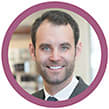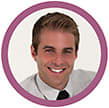
WHAT’S ALL THE FUSS ABOUT MYOPIA?
For starters, the following commonly shared statistic paints the picture of a serious need:

If left untreated, 5 billion people worldwide are expected to be myopic by 2050.
But that’s just the beginning of the story. Fast-forward to their adulthood, and here’s the picture Richard Abbott, M.D., past president of the Academy of Ophthalmology, paints for those myopes. “They have a 50% greater risk of glaucoma, are 17% more likely to need cataract surgery, and have a six times greater risk of retinal detachment and retinal tears,” he says.
For young myopes and their families in the U.S., there is, however, some good news. As detailed in our feature here, myopia management products and programs are multiplying at a record rate. And so is the attention of eyecare professionals, as more and more are putting increased time and effort into treating these young patients.
THE ECP PERSPECTIVE
To get a variety of perspectives, EB sought out three optometrists in different practice modalities and geographic settings. The common ground? All have made myopia management for young people a practice priority.
Andrew Neukirch, O.D., owner of Carillon Vision Care in Glenview, IL, says, “Most established kids currently in our program are in ortho-k simply because it’s been available for years and has widespread adaptation. Most new ‘myopia starts’ in the past year though have been put in the new MiSight lens.”
In Apex, N.C., David Holler, O.D., brought myopia management into the six-location Clarity Vision operation he heads several years ago. “We’re seeing a rapid increase in myopia from a younger age and with a faster progression,” he explains.
How does he approach the subject with parents? “I’ll bring statistics up on the computer and say, ‘Based on age, race, and current prescription, this is where your child’s prescription will be at age 17,’” he says. “I’ll usually print something off to give them so they can talk to their spouse.”
With two locations in the Los Angeles area, Ryan Stybel, O.D., provides myopia management services with the Treehouse Eyes model in his Manhattan Beach Look! Optometry location. “For us, it’s being able to give better care, plus consistent treatment and management by following up every three months, taking multiple axial length measurements and, business-wise, really being able to pivot,” he shares.
Why Treehouse Eyes? “I realized I really wanted to make this a part of my practice to set us apart, specialize in it, and to have the correct training,” says Dr. Stybel. “In order to do that, there was already a company that had created the protocol for it, and I’m a believer of if you want to be the best, align yourself with the best.”



EYEING THE OPTIONS
What programs and products are ECPs like the ones we interviewed espousing?
From eye drops to multifocal contacts, and ortho-k to PAL and SV lenses, myopia management options continue to multiply. Here’s a look at some of those products and programs, including several new global releases, some of which are awaiting approval for U.S. distribution.
- Acuvue Abiliti, a new brand announced by Johnson & Johnson Vision this spring, including its Overnight Therapeutic Lenses, the first ortho-k lenses to be FDA-approved for myopia management. The company also recently announced a new collaboration with Menicon to develop contact lenses to help manage myopia progression. seeyourabiliti.com
- Brilliant Futures Myopia Management Program by CooperVision, built around MiSight 1 day soft contact lenses. CooperVision also produces an ortho-k contact lens. coopervision.com/practitioner/myopia-management
- Euclid MAX, a new overnight ortho-k design that was announced by Euclid Systems in May and has already received FDA approval. euclidsys.com
- MiYOSMART by Hoya, a spectacle lens utilizing Defocus Incorporated Multiple Segments (DIMS) technology that won the Silmo d’Or in Vision award at last year’s Silmo Paris. hoyavision.com/my/discover-products/for-eye-care-professionals/special-lenses2/miyosmart/
- MyoVision Pro and MyoKids, single-vision lenses by Zeiss, applying Peripheral Defocus Management. zeiss.com
- SightGlass Vision spectacle lenses, a 50/50 joint venture of EssilorLuxottica and Cooper Companies announced in February. sightglassvision.com
- The Stellest spectacle lens by Essilor, which received FDA “Breakthrough Device” designation in May and was first released in China last year, as well as its MyopiLux Max prismatic bifocal. essilorpro.com

DECIDING FACTORS

Age. At what age do these O.D.s start treatment? “We’ve done axial length measurements on a 3 1/2-year-old,” says Dr. Stybel. “If a 4-year-old is starting to show some myopia, then that’s a patient who needs treatment because it’s better to start earlier than later.” Dr. Holler adds, “We’ll talk about it from the age of 4 to 6 at the earliest. Most kids aren’t showing it till around 6 to 8.”

Profitability. From a business perspective, O.D. experts agree that myopia management is definitely profitable. “One myopia management patient in our practice is worth more than 10 vision plan patients,” says Dr. Neukirch. “This allows us to spend more time with these specialty patients and ultimately allows us to deliver better care.”

Fees. As for fees, he adds, “Our treatment plans are broken down into a flat monthly fee. We never mention it in terms of an annual cost.”

Focus. Best tips for myopia management success? “Don’t just do myopia management as something you do,” says Dr. Stybel. “If it’s something you’re passionate about, you like seeing patients, and you want to make a difference, educate yourself, specialize in it, and have the right technology.”
Dr. Neukirch agrees. “It’s really easy to get all excited and start a subspecialty and then watch it never take off,” he says. “Make sure you do it 100%. Study the research. Get certified on multiple platforms. Buy the equipment you need (topography and biometry have already become standard of care). And, if you’re an owner trying to get your associate to launch a subspecialty, they are never going to do it well on their own. You need to be actively involved as well!”

PHOEBE SAYS...
Phoebe Lee is 10 years old, and in this one-on-one exclusive interview with EB, she shares her experience dealing with myopia.
Q. Tell us about yourself and your vision problems.
A. I started wearing MiSight 1 day when I was 9 years old. I like to play tennis, play piano, and read. In school, I had trouble seeing the whiteboard, and at home, my parents noticed I was squinting a lot.
I didn’t like to wear my glasses [when I play tennis] because I was afraid the ball would hit me in my face and break them.
Q. Did you try anything else?
A. We tried atropine drops to start, but I always forgot to put them in. That’s why my eye doctor, Andrew Neukirch, O.D., suggested MiSight 1 day contact lenses. He thought they would be a better fit for me. He’s nice and made sure I was comfortable with applying and removing my contacts.
Q. How has your vision changed?
A. I went to my first eye appointment and I was a -0.75D. Then at my second, my prescription was a -2.00D in one eye and a -2.25D in the other, so that’s when he told us about MiSight. My prescription is currently -2.00D in one eye and -2.25D in the other.
Q. What difference do the lenses make for you?
A. I can see everything clearly at school, at home, and on the tennis court and soccer field. I love wearing my contact lenses!
[Phoebe’s mom, Patty, underscores the importance of finding the right solution for children. “We have a chance to do something to really impact our kids’ lives,” she explains. “Their futures, their activities, their schooling are all affected by their eyesight. I’m excited there’s an option out there for parents who truly care about our kids’ vision.”]

For additional myopia management programs and new international initiatives, view EB’s Web Exclusive here.



